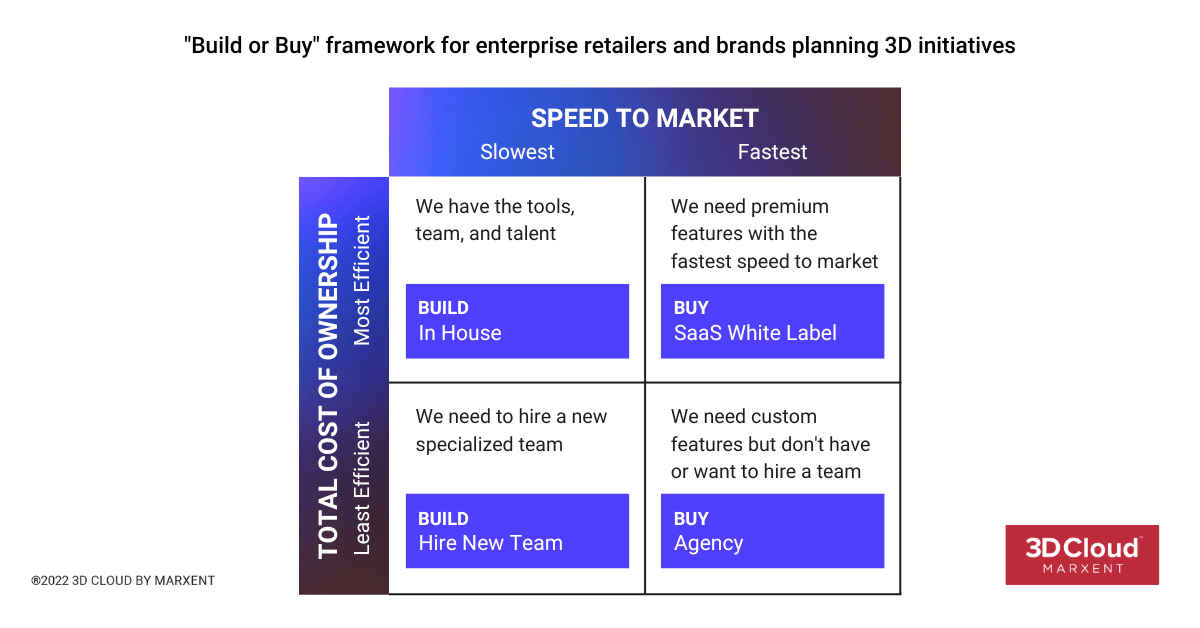Download PDF Template
Download PowerPoint Tempate | Download PNG
This article covers:
- A framework for deciding whether to build 3D capabilities in-house or outsource to a third party.
- 5 questions to ask when deciding to build vs. buy
- FREE TEMPLATE: Use our free build vs. buy framework template to help communicate the options to an executive team or board.
As you define your 3D strategy, one of the key decisions to make is whether to use your existing talent, to hire new talent, or to outsource the project to a third party vendor.
This article will give you a framework for making smart decisions that take key considerations like speed to market and cost efficiency into account.
If you are a retail, e-commerce, technology, product, or marketing leader working on a strategic 3D initiative, this article is for you.
When building an enterprise 3D strategy and business case, one of the hardest decisions is deciding whether to build a solution in-house or to work with a third-party vendor. This article lays out the key considerations for a build vs. buy decision.
How to decide whether to build a 3D project in-house or to work with a vendor
The 3D Cloud Build or Buy Framework is a simple way to approach discovery on the most important factors in deciding whether to build a 3D project in-house or to work with a vendor.
The two major considerations that play into this decision are
- Speed to Market – The amount of time that it takes to launch a new product or experience
- Cost Efficiency – The total cost of a given approach (build vs. buy) over time
If an organization needs to bring a solution to market quickly, it will likely choose to outsource. An organization with a lot of time, budget, and strategic priority to build out an internal 3D business unit may choose to build a solution in-house over several years before ever bringing an initiative to market.
5 questions that reveal which approach is right for your situation
1. Is your 3D project a campaign or a utility that requires future proofing?
If your initiative is a one-time 3D experience for a marketing campaign, it requires a much different approach than a utility or productivity tool that you intend to use enterprise-wide.
- If the 3D initiative is a one-time campaign with one-time-use assets, consider outsourcing the initiative to an agency. Building an in-house team will be too slow, and a SaaS white label will be unnecessarily feature-rich.
- If the 3D initiative is a utility or productivity tool that requires futureproofing and the plan is to deploy in less than a year, outsource it to a SaaS white label. An agency will be too slow, expensive, and difficult to maintain over time. Doing it in-house will require a long runway and a large, specialized team. Some companies, like IKEA, have been successful with this strategy, but for most retailers, it is difficult to get in-house efforts to take flight. Eventually, most companies that start in-house turn to a 3rd party vendor for help.
2. Do you have a plan for additional or future 3D experiences?
The use cases for 3D in retail are endless. If you have plans to continue to grow your 3D strategy beyond a single application, take these architectural and infrastructural components into consideration:
- A 3D content pipeline
- Software to build 3D content
- A centralized 3D Content Management System (CMS) for reviewing, approving, and deploying 3D content across multiple experiences. A CMS acts as a single source of truth and ensures reuse and consistency across use cases.
- 3D Design and Visualization applications that align with business needs, e.g., WebAR, 3D Product Configurators, 3D Room Planners, and so on.
- Analytics dashboards and internal CRM systems
- Security and privacy regulatory requirements
- Data protection and encryption methods that adhere to regulatory requirements
- Software and QA automation tools
- Software monitoring tools to ensure stability, performance, and scalability
3. Does the organization have the specialized skills and structure to successfully deliver on a 3D initiative?
There are a range of jobs involved in launching a 3D initiative, whether you choose to build in-house or outsource to a third-party vendor. Typical roles that span all methodologies in the framework and are easy to fill with existing retail headcount include merchandising and marketing team members who provide input around what content to model, application features, promotion, and so on.
The more challenging roles to fill in an “in-house build scenario” are specialized 3D artists, software developers, and QA talent. These more specialized roles include:
- 3D artists / graphic designers who specialize in 3D content creation
- Product Manager(s) / Product Owner(s)
- Project Manager(s)
- Enterprise Architecture team
- UX Engineers
- Software Dev Engineers
- Software QA resources
- Data Engineers and/or Business Intelligence / Analytics team members who can help connect events data to analytics & insights
Note your financial model should include fully loaded costs of these FTEs (salary, benefits, etc.).
A third-party vendor can reduce or completely eliminate the need to create an entire business unit dedicated to your 3D initiative. In fact, if you work with the right vendor, you may not need to hire any net-new headcount at all. This article lends insight into what resources are required when working with 3D Cloud by Marxent.
4. How fast do you need to bring the 3D initiative to market?
If you have a need for speed, it’s almost always faster to work with a vendor. If you have a long-term strategic initiative, working with a vendor with an established customer success program can ensure that your investment pays off over time and is properly managed and staffed. Retailers who see themselves as software companies and who have a lot of time and budget may choose to hire a specialized team and build out a 3D business unit. We’ve seen this model work with limited success. It’s hard to bring new 3D initiatives to market from within the operating structure of a retail business without support from a specialized vendor.
5. What are my company’s organizational strengths?
Is your company a software company, a retailer, or somewhere in between? It’s not hard to build and publish a dozen or even a few hundred 3D models, but 3D at scale for large catalogs is a different story. Some major retailers have full-blown 3D business units and do everything in-house, but it isn’t realistic for retailers to hire hundreds of people to fuel their 3D content and application needs.
We have encountered companies that start out trying to build 3D capabilities in-house, only to discover that it requires much more than they anticipated. They get frustrated with the development process. Or, they underestimated the cost of building the platform and/or underestimated the cost of maintaining such a platform. Standing up a 3D platform, 3D content management system and real-time 3D experiences are time-consuming and capital-intensive if not done correctly.
Take an honest look at your organization’s strengths and weaknesses and ability to deliver all that is needed and where you may need help from third-party providers.
FREE TEMPLATE: Build vs. Buy Framework for 3D Initiatives
Use this Powerpoint slide template to help frame the story and the investment options you are considering, looking at the high-level cost-benefit and trade-offs for each.
- Interview stakeholders to understand key factors such as required delivery timelines, long-term visions, ability to build a team in-house, and so on.
- Collaborate with your finance team on a project model that reflects the cost of software, hardware, and personnel for various options.
- Use this slide to bolster your business case presentation to senior leadership or the board of directors.
Download the Build vs. Buy Framework – Strategic Options for Successful 3D Initiatives
Download PDF Template
Download PowerPoint Tempate | Download PNG

Making a build vs. buy decision
Filling out the build vs. buy framework and circulating it internally will give you a good sense of how to move your 3D initiative forward successfully. Gathering all of this information upfront is invaluable and can save you false starts, unnecessary re-work, and unnecessarily drawn-out timelines. It’s well worth the time.
Once you’ve made your build vs. buy decision, what’s next?
Once you’ve made a build vs. buy decision, and If you’ve decided to use a vendor, the next step is to research vendors.
For a complete guide to launching a 3D project, visit our 3D Project Planning Resource Center.
Are you ready to get started in defining your 3D investment strategy? Contact Us here or Request a Demo.













